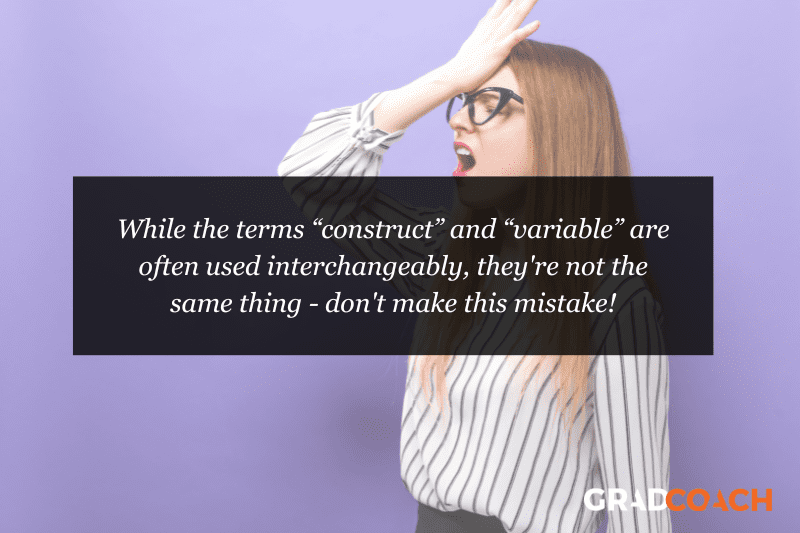 Research Methodology 101" width="800" height="500" />
Research Methodology 101" width="800" height="500" />Navigating the world of academic research can be overwhelming, especially if you’re new to the field. One of the many pieces of terminology that often trips students up is that of the “research construct”. In this post, we’ll explain research constructs, construct validity and reliability in simple terms along with clear examples.
Simply put, a research construct is an abstraction that researchers use to represent a phenomenon that’s not directly measurable – for example, intelligence, motivation or agreeableness. Since constructs are not directly measurable, they have to be inferred from other measurable variables, which are gathered through observation. For example, the construct of intelligence can be inferred based on a combination of measurable indicators such as problem-solving skills and language proficiency.
As a researcher, it’s important for you to define your constructs very clearly and to ensure that they can be feasibly operationalised. In other words, you need need to develop ways to measure these abstract concepts with relevant indicators or proxies that accurately reflect the underlying phenomenon you’re studying. In technical terms, this is called construct validity – we’ll unpack this in more detail a little later.
 Research Methodology 101" width="800" height="500" />
Research Methodology 101" width="800" height="500" />
The best way to get a feel for research constructs is to look at some examples. Some common examples of constructs that you might encounter include:
As you can see, all of the above examples reflect phenomena that cannot be directly measured. This is the defining characteristic of a research construct and is what distinguishes a construct from a variable (we’ll look at that next).
See how Grad Coach can help you.
In research, the terms “construct” and “variable” are often used interchangeably, but they’re not the same thing.
A variable refers to a phenomenon that is directly measurable and can take on different values or levels. Examples of variables include age, height, weight, and blood pressure. Notably, these are all directly measurable (using basic equipment or just good old-fashioned logic).
In contrast, a construct refers to an abstract concept, that researchers seek to measure using one or more variables – since it is not directly measurable. Self-esteem, for example, is an abstract concept that cannot be directly measured. Instead, researchers must use self-reported indicators such as feelings of self-worth or pride in oneself to create operational definitions (variables) to measure it.
Another difference between research constructs and variables is their level of abstraction. Constructs tend to be more abstract than variables since they represent broad ideas and concepts, while variables are specific measures within those concepts. If you’d like to learn more about variables, be sure to read this article.

When it comes to creating and/or using research constructs, there are two important concepts you need to understand – construct validity and reliability.
Construct validity refers to the extent to which a research construct accurately measures what it is intended to measure. In other words, are you actually measuring the thing that you want to measure, as opposed to some other thing that just happens to correlate? For example, if you wanted to measure intelligence using some sort of performance test, you’d need to ask questions that truly reflect the participant’s cognitive abilities and not just their memory recall.
Construct reliability, on the other hand, relates to how consistent the measurement of a construct is over time or across different situations. This focus on consistency serves to ensure that your results are not simply due to random error or inconsistency in data collection. To improve construct reliability, researchers use standardized procedures for collecting data, as well as measures such as test-retest reliability, which involves comparing results from multiple measurements taken at different times. You may have also heard of Cronbach’s alpha, which is a popular statistical test used to assess internal consistency, and in turn, construct reliability.
Both construct validity and reliability play crucial roles in ensuring accurate and meaningful research findings. If the constructs you use in your research are not valid and reliable, your data will be largely meaningless. So, be sure to pay close attention to these when designing your study.
We’ve covered a lot of ground in this post. Let’s do a quick recap of the key takeaways:
Keep these point front of mind while undertaking your research to ensure your data is sound and meaningful. If you need help with your research, consider our 1:1 coaching service, where we hold your hand through the research journey, step by step.

This post was based on one of our popular Research Bootcamps. If you're working on a research project, you'll definitely want to check this out.